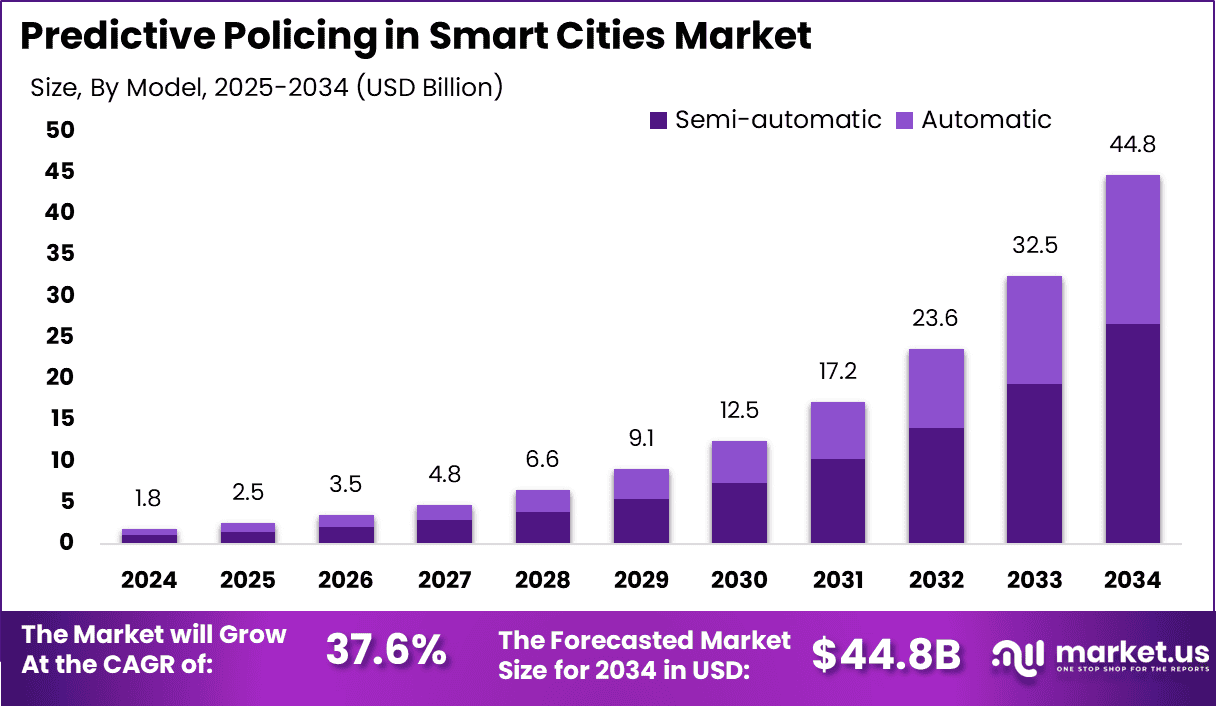Table of Contents
The Global Predictive Policing in Smart Cities Market is experiencing exponential growth, expected to rise from USD 1.8 billion in 2024 to approximately USD 44.8 billion by 2034, growing at a CAGR of 37.6% from 2025 to 2034. In 2024, North America dominated the market with a 41.8% share, generating around USD 0.7 billion in revenue.
The adoption of AI-driven analytics, real-time surveillance integration, and crime forecasting tools is transforming urban law enforcement strategies. Smart city initiatives are accelerating investment in predictive policing systems to improve public safety, optimize police deployment, and reduce crime rates through data-backed decision-making.

How Tariffs Are Impacting the Economy
Tariffs on imported surveillance equipment, AI processors, and cloud infrastructure components are increasing the deployment costs of predictive policing systems. The U.S. International Trade Commission reports that tariffs on tech imports from China and the EU—often used in surveillance cameras, GPUs, and communication modules—have elevated costs by 10–15%.
➤ Discover how our research uncovers business opportunities @ https://market.us/report/predictive-policing-in-smart-cities-market/free-sample/
This inflation not only affects municipal procurement budgets but also delays smart policing projects. Furthermore, strained trade relations slow technological exchange, hindering innovation in cross-border AI development. Rising costs reduce access for smaller municipalities, risking a digital divide in public safety technology. The result is a slower rollout of smart city security infrastructure, ultimately impacting economic stability and societal resilience.

Impact on Global Businesses
Rising Costs: Predictive policing relies on high-performance analytics hardware and cloud infrastructure, both of which face price hikes due to tariffs.
Supply Chain Shifts: Vendors are diversifying sourcing to tariff-free zones like South Korea and Mexico, leading to logistical complexity.
Sector-Specific Impacts:
- Urban Surveillance Providers: Face increased costs in scaling camera and sensor networks.
- AI Software Developers: Delay in deployment due to hardware compatibility and pricing constraints.
- Smart City Contractors: Budgets under pressure from increased import duties on foundational technology, affecting timelines.
Strategies for Businesses
- Establish domestic hardware partnerships to avoid tariffs and ensure compliance.
- Leverage modular AI tools that integrate with existing infrastructure.
- Advocate for municipal and federal subsidies to offset rising costs.
- Utilize open-source platforms for predictive analytics to reduce licensing overhead.
- Invest in cybersecurity and ethical AI frameworks to boost stakeholder trust.
Key Takeaways
- Market to reach USD 44.8 billion by 2034, growing at 37.6% CAGR
- North America holds a 41.8% share, generating USD 0.7 billion in 2024
- Tariffs increase AI hardware and cloud system costs by 10–15%
- Small municipalities face challenges accessing smart policing technologies
- Businesses are adopting modular solutions and local sourcing to remain competitive
➤ Get full access now @ https://market.us/purchase-report/?report_id=148118
Analyst Viewpoint
Currently, the predictive policing market is driven by urgent public safety needs and smart city investments. While tariffs disrupt hardware affordability, the underlying momentum remains robust due to the pressing demand for crime reduction and efficient policing. The future of predictive policing lies in real-time data fusion, ethical AI integration, and proactive threat detection. Cities that invest in transparent and community-focused AI adoption will not only enhance safety but also public trust.
Regional Analysis
North America leads the market with a 41.8% share, thanks to early smart city programs, advanced AI infrastructure, and public-private security partnerships. The U.S. alone contributes the majority of regional revenue, driven by large-scale city-level deployments. Europe is following closely with strict GDPR-compliant AI initiatives in public safety.
Asia-Pacific is emerging as a major growth hub, particularly in China, Singapore, and India, where urbanization is pushing the demand for integrated safety networks. Middle Eastern cities are also making significant investments in predictive policing as part of their smart infrastructure overhaul.
➤ Discover More Trending Research
- Projection-Based Digital Signage Market
- Multimedia Chipsets Market
- Embedded Security Market
- Private Aircraft Market
Business Opportunities
The market opens strong opportunities in cloud-based crime mapping platforms, AI-driven facial recognition systems, autonomous surveillance drones, and real-time emergency response tools. Vendors offering low-cost, scalable, and privacy-compliant AI tools are likely to gain traction in developing smart cities.
Additionally, ethical AI consulting, training for law enforcement, and cybersecurity services tailored to predictive policing systems present high-growth segments. Businesses that combine technology with legal and ethical compliance will differentiate themselves in this increasingly scrutinized market.
Key Segmentation
The predictive policing in the smart cities market is segmented by:
- By Component: Hardware (Cameras, Sensors), Software (Analytics Platforms, Facial Recognition, Crime Mapping), Services
- By Deployment: On-Premise, Cloud-Based
- By Application: Crime Forecasting, Surveillance, Emergency Response, Traffic Monitoring
- By End User: Municipal Governments, Law Enforcement Agencies, Private Security Operators
In 2024, Crime Forecasting and Real-Time Surveillance dominated the applications segment, while Cloud-Based deployment is rapidly gaining preference for its scalability and cost efficiency.
Key Player Analysis
Leading firms in this market are focusing on AI-driven crime prediction algorithms, cloud-integrated analytics, and data privacy compliance tools. They are investing in urban infrastructure partnerships with law enforcement agencies to co-develop predictive systems.
Strategic moves include expanding into Asia-Pacific and Europe, enhancing multi-lingual user interfaces, and building interoperability with public safety apps. These players are increasingly emphasizing bias mitigation and community transparency to align with public and regulatory expectations for responsible policing technologies.
Top Key Players in the Market
- Palantir Technologies
- SoundThinking
- Esri
- Flock Safety
- Motorola Solutions
- IBM
- Microsoft
- StaquTechnologies
- ThirdEyeLabs
- Axon
- Other Major Players
Recent Developments
In 2024, several providers introduced next-gen AI surveillance platforms capable of real-time crowd behavior analysis and threat detection, receiving pilot deployment approvals in multiple U.S. and European cities.
Conclusion
The predictive policing market is set for rapid expansion as cities worldwide prioritize security and smart governance. Despite tariff headwinds, innovation, strategic sourcing, and ethical AI practices will enable the sector to meet future urban safety demands effectively.
Discuss your needs with our analyst
Please share your requirements with more details so our analyst can check if they can solve your problem(s)



